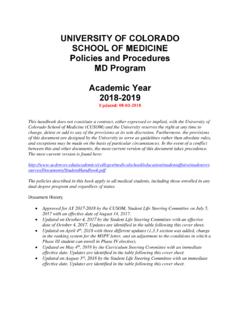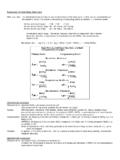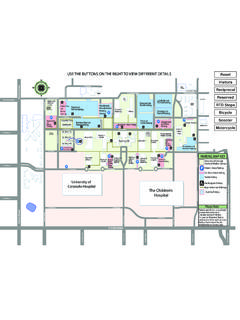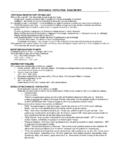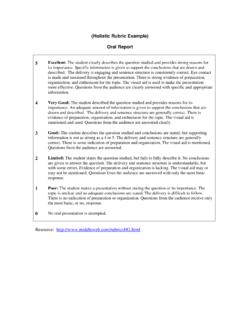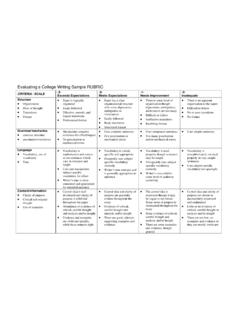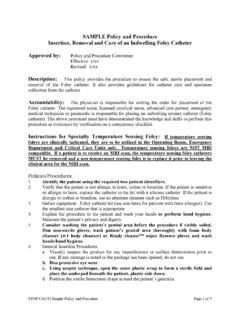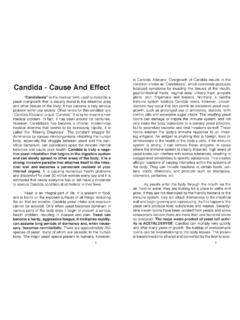Transcription of TEACHING OBJECTIVES: Design an educational plan with …
1 TOPIC:Diabetes DiseaseProcess (type 1) TEACHING objectives : Design an educational plan withthe family that will ensure anadequate diabetes knowledgefoundation on which to OBJECTIVES: Learners (parents, child, relative orself) will be able to:1. List two causes each for type 1and type 2 State one major difference inthe treatment of type 1 and 3T ype 1 DiabetesType 1 diabetes is one of the most common chronicdisorders of childhood. Unfortunately, it is increasing inincidence, particularly in young children. The reason for this isunknown, although it is most likely related to the environment(see below). It is also the most common form of diabetes tooccur in people under age 40. Type 2 is the most commonform after age 40. The list of famous people: sport stars,politicians, movie stars and artists, who have type 1 or type 2diabetes is long. Following diagnosis, children frequentlydiscover classmates who also have diabetes.
2 Their looks,personalities and activities are no different from those ofanyone rate of development of type 2 diabetes in children hasincreased in recent years. There is also a worldwide increase intype 2 diabetes in adults. This is due primarily to eating highcalorie and high fat foods as well as a lack of exercise resultingin excess weight gain. Type 2 diabetes will be discussed inChapter know that diabetes is not catching, like a cold. We alsoknow that type 1 diabetes isn t caused from eating too risk factors seem to be important in determiningwhy a person develops type 1 diabetes:1. inherited (or genetic) factors 2. self- allergy (autoimmunity)3. environmental damage ( , from a virus or chemical)1516 Chapter 3 Type 1 Diabetes1. Inheritance (genetic)The first important reason seems to be aninherited or genetic factor, such as the way aperson inherits the color of the eyes from amother, father or other about inheritance:People with type 1 diabetes are more likely tohave inherited certain cell types (called HLAtypes).
3 Those who don t have diabetes areless likely to have these HLA HLA types are determined by usingwhite blood cells(WBCs) for typing. Bloodtypes (A, B, AB and O) are determinedusing red blood all people with type 1 diabetes havean HLA type DR3or percent of people with type 1diabetes have one DR3 and one DR4, withone of these coming from each three percent of people withoutdiabetes have this DR3/DR4 combination makes a person morelikely to develop diabetes. This is especiallytrue when they have a relative with half of the families (up to 90 percentin one study) have no close relative withtype 1 diabetes. Perhaps a family has a DR3or a DR4 gene, but no family member hasever married into a family with the otherDR gene. If a family member with a DR3gene then marries into another familycarrying the DR4 gene, the child may endup with the DR3/DR4 combination.
4 Theymay then be at high risk for diabetes. It is now known that there are also differentgenes that help to protect a person fromdeveloping from a family who have a childwith diabetes have a greater chance ofdeveloping it than without a family brother or sister of a child with diabeteshas about a 1 in 20 (five percent) chance ofdeveloping cause is not completely due to know this from studies of identicaltwins. When one identical twin getsdiabetes, only in half of the cases does theother twin also develop the disease. If itwere entirely due to heredity, both twinswould always develop it. We don tcompletely understand the inheritancefactors. We do believe that bothmotherand father transmit the tendency to developdiabetes to their Self- allergy (autoimmunity)The second cause that seems to beimportant in type 1 diabetes is self- allergy (orautoimmunity).
5 Normally, our immune systemsprotect our bodies from about self- allergy (autoimmunity):In the case of type 1 diabetes and otherautoimmune diseases such as lupus, arthritisand multiple sclerosis, the immune systemturns against a body can be evidence of this allergicreaction found in the blood. The allergicreaction is against the cells in the pancreas(islet cells) that make insulin. Most Angloand about half of Hispanic and African-American children show this allergy whenthey develop diabetes. The evidence in theblood is called an antibody or, morespecifically, an islet cell antibody (ICA).We now know that some people can havethis antibody present in their blood formany years before they need diabetes antibodies calledbiochemical antibodies ( GAD antibodies,insulin autoantibodies [IAA] and ICA 512antibodies) can now be measured. They areeasier to measure and have also been foundin the blood of people who are these antibodies in the blood hasmade it possible to screen people who are atrisk to develop diabetes.
6 This screening haslead to research trials (see Chapter 28)which will try to prevent diabetes. WeChapter 3 Type 1 Diabetes17believe it is important for brothers, sistersand other relatives to have this screening. The antibodies gradually disappear from theblood after the onset of type 1 one year, many people will no longerhave them. People who develop type 2 diabetes(previously called adult-onset) do not havethese antibodies, even if they are under age21 at onset. 3. Environmental (virus or chemical)A third factor is also believed environmental factor may either be a virusor something in the food we eat or somethingwe do not yet know about. This factor may bethe bridge between the genetic (inherited) partand the allergic example of the sequence of events might be: A person inheritsthe tendency for tendency might allow a virus to injurethe islet of the damaged islet cell may then bereleased into the body would then make islet cellantibodies (an allergic or autoimmunereaction).
7 The damage can attract white blood cells(WBCs) to the area of the islet. These nowactive WBCs produce chemicals, whichfurther injure the other islet that activates the WBCs in thefuture (viral infections, certain foods, stress,etc.) may result in more of the islet cellsbeing now know that most people who getdiabetes don t just suddenly develop it. Theyhave been in the process of developing it formany years, sometimes even from birth. Mostlikely many viral infections and other factorsresult in damage and destroy a few more isletcells. As more and more islet cells are destroyedthe person moves closer to having diabetes (seeFigure below where diabetes is represented bythe broken line).MICROSCOPIC PHOTOGRAPH OF PANCREATIC ISLET:The photo on the left shows a normal islet (center) surrounded by other pancreatic tissue. This other tissue isresponsible for making digestive enzymes.
8 The photo on the right is from a diabetic animal. The whiteblood cells (WBCs) have invaded and destroyed the 3 Type 1 DiabetesTYPE2 (ADULT-ONSET) DIABETES: Chapter 4 explains type 2 diabetes in three main risk factors for type 2 diabetesare:1. Overweight2. Insulin insensitivity3. Inheritance (genetics)1. Overweight (obesity): is an important riskfactor for type 2 (adult-onset) diabetes. Incontrast, it is not a risk factor for type 1diabetes. 2. Insulin insensitivity: Insulin does not seemto work normally in the person with type 2diabetes. Initially it can still be made innormal or above-normal amounts. This isdifferent from type 1 diabetes, where insulincannot be made at all or is made in smallamounts. Later, people with type 2 diabetesmay also have reduced insulin will then need insulin Inheritance (genetics): Type 2 diabetesalso has a strong inherited (genetic) with type 2 diabetes do not have thesame association with the HLA genes as dopeople with type 1 diabetes.
9 They also donot make islet cell antibodies. The causes ofthe two types of diabetes seem to becompletely to Islet CellsIt is now believed that diabetes develops gradually, over many months or many years. Itdoes not just come on suddenly in the week or two before the elevated blood sugars. Manyinsults (represented by the arrows in this Figure) likely result in further damage until thediagnosis of diabetes is made. The insults may include viral infections, stress, chemicals in thediet or other agents. These agents may work by activating white blood cells in the islets tomake toxic chemicals that cause injury to the insulin-producing cells (beta cells). However, a genetic-predisposition (inherited factors) must be present for the process to Gradual Onset of Type 1 DiabetesTime in Months or Years (variable for different people)Diabetes (with elevated blood sugar) Honeymoon InsulinProduction(%)Chapter 3 Type 1 Diabetes19 DEFINITIONSA llergy: A special reaction of the body to somematerial.
10 This is similar to what happens if youare allergic to something that makes : The material we measure in theblood if someone has an allergy (example: milkantibodies might be present if someone has amilk allergy ).Autoimmunity (self- allergy ): The process offorming an allergic reaction against one s owntissues. This happens in diseases such as lupusand arthritis. People with type 1 diabetes makean antibody against their islet cells (where theinsulin is made).Genetic (inherited):Features, such as eyecolor, that are passed from both parents type: The way to group cell types just asred blood cells are grouped into A, B, AB andO blood types. HLA stands for HumanLeukocyte Antigen. A leukocyte is anothername for a white blood cell. The white bloodcell is the type of cell used in HLA twins: Twins that come from thesame egg. All their features (genetics) areexactly cell (pronounced eye-let): The groups ofcells within the pancreas that make cell antibody: The material we measurein the person s blood to show that they havehad an allergy against the cells in the pancreas(the islet cells) that make AND ANSWERSFROM NEWSNOTESMy daughter was in a car accidentthe week before the onset of herdiabetes.
